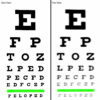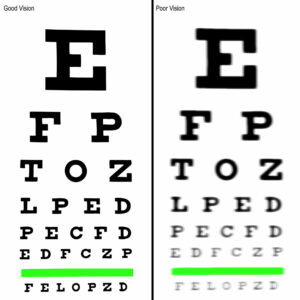
Can LASIK Eye Surgery Cure Myopia?
Myopia is more commonly referred to as nearsightedness. It’s a condition that makes close objects appear clear, but objects that are farther away appear blurry. This condition occurs when a person’s eyeball is too long. Or, if the cornea, which is the front covering of your eye, has an excessive curvature. So can LASIK cure myopia?
When this occurs, the light that enters the eye does not focus correctly, which causes objects in the distance to appear blurred.
Myopia affects almost 40 percent of people in the U.S. There are some studies that have concluded that the occurrence of nearsightedness is a hereditary trait. However, there is also new evidence that nearsightedness is due to visual stress from too much work up close.
Signs of Nearsightedness
One of the most common signs of nearsightedness is that objects in the distance appear blurry. For example, the television screen, movie screen, or chalkboard (for younger individuals).
An eye exam from an optometrist will be able to determine if you suffer from nearsightedness.
Diagnosis Methods for Nearsightedness
During an eye exam, the optometrist will use several tests to measure how your eyes focus light. Then they’ll determine the amount of power that is needed for an optical lens to correct your vision problem.
Distance Chart
 This is one of the most common tests when visiting the eye doctor. The doctor asks the patient to read letters on the distance chart, which will measure visual acuity. This measurement is written as a number, 20/20 for example.
This is one of the most common tests when visiting the eye doctor. The doctor asks the patient to read letters on the distance chart, which will measure visual acuity. This measurement is written as a number, 20/20 for example.
The top number represents the distance at which the testing occurs. The bottom number represents the smallest letter that the person could read. For example, if a person has 20/40 vision, they read the chart at a distance of 20 feet. The smallest letter that could be read was a letter that could be seen at 40 feet by the normal eye.
Another tool an optometrist may use to test vision is a phoropter. This includes placing a lens in front of a person’s eyes and then measuring how they focus on the light. They do this by using a hand-held instrument known as a retinoscope.
The testing can be done with or without the use of eye drops. The drops’ main purpose is to keep the eyes from changing focus when the testing is going on. Once the doctor gathers all information, they will be able to determine if the patient suffers from nearsightedness.
Treatment Methods for Nearsightedness
There are several different methods that a doctor can use for the treatment of nearsightedness. The most popular types of treatment are:
1. Glasses or Contacts
The most common treatment for a person suffering from nearsightedness is the prescription of corrective lenses. They come in the form of glasses or contacts. These will be shaped to bend the images that enter the eyes and focus the light. Then, the images are perceived clearly at the back of the eye.
Some individuals only have to wear corrective lenses for certain activities, such as driving or watching television. However, if the condition is severe, the individual may have to wear corrective lenses all the time.
2. Orthokeratology
Orthokeratology is more commonly referred to as corneal refractive therapy. This is a procedure that does not require surgery. Instead, you wear a series of custom-designed contact lenses that are extremely rigid. These lenses work to reshape the curvature of the cornea in a gradual manner. The lenses place pressure on your eye’s cornea in order to flatten it. This will change how the light enters your eye and the manner in which it focuses.
3. Refractive Surgery
If you suffer from high levels of nearsightedness, refractive surgery options are available. This procedure involves the implantation of a small lens that gets placed directly into the eye. It will either be placed in front of the natural lens, which is referred to as a phakic intraocular lens implant. Or, complete replacement of the natural lens, which is known as clear lens extraction with intraocular lens implantation. This procedure is very similar to the procedures used for patients that suffer from cataracts.
4. LASIK Surgery for Myopia
Instead of removing the tissue from the surface of your cornea, LASIK surgery will remove tissue from the inner layers. The outer surface of the cornea is cut and then folded back in order to expose the tissue that is inside. Then the laser is used to completely remove the exact amount of tissue needed. This is done to successfully reshape the eye. Once the reshaping is completed, the outer flap of tissue is put back into the proper position for healing.
When LASIK is used for nearsightedness, the effectiveness is limited. This is due to the amount of tissue in the cornea that can be removed safely. In some cases, individuals who are extremely nearsighted have corneas that are too thin to safely use LASIK procedures. Instead, these individuals may need to have their vision corrected by having small lenses implanted into their eyes.
Natural Alternatives and Vision Therapy to Cure Myopia
Keep in mind there are risk factors that accompany any surgery. You don’t necessarily need to take the risks that LASIK surgery presents when there are natural methods for improving vision. For example, learn about the various eye exercises you can do from home. Over time, you can strengthen your eye muscles which were once weak. Stronger eye muscles allow you to focus your lens so you can see distant objects more clearly. Eye exercises along with a balanced and healthy diet can help. Try to eat lots of colorful natural foods, like dark leafy greens. At the very least, these changes can prevent eye diseases from developing.
Not everyone has time to cook healthy and colorful meals each day. That’s where supplements come in. Natural vision improvement supplements, like our Ocu-Plus Formula, can provide the essential vitamins and nutrients to strengthen and relax your eye muscles. These vitamins can improve your vision and may be able to completely eliminate the need for corrective lenses.
Our Rebuild Your Vision Ocu-Plus Formula Contains All 17 Vitamins, Minerals, and Herbal Supplements to Improve Your Eye Health!












My son has myopia i was in if gets the lasek surgery can it cure his myopia. Its only in 1 eye. It it guarantee to cure his myopia. I really need to know so i can help him with the surgery. Please let me know if its safe and guarantee. Thank you and i would gladly need a response.
If I use natural techniques, how long will it take me to see results ?
Lasik correction sounds scary.
Thank you for the thought provoking emails.
I was wondering – can close vision still be improved by natural means even though a person has had eye surgery previously for myopia?
Looking forward to your response.
Regards,
Amy
Hi Amy,
Most definitely. Check out some testimonials and success stories after Lasik surgery and how they improved their vision at https://www.rebuildyourvision.com/eye-vitamins/ (scroll down to see testimonials).
Let us know how else we can help.